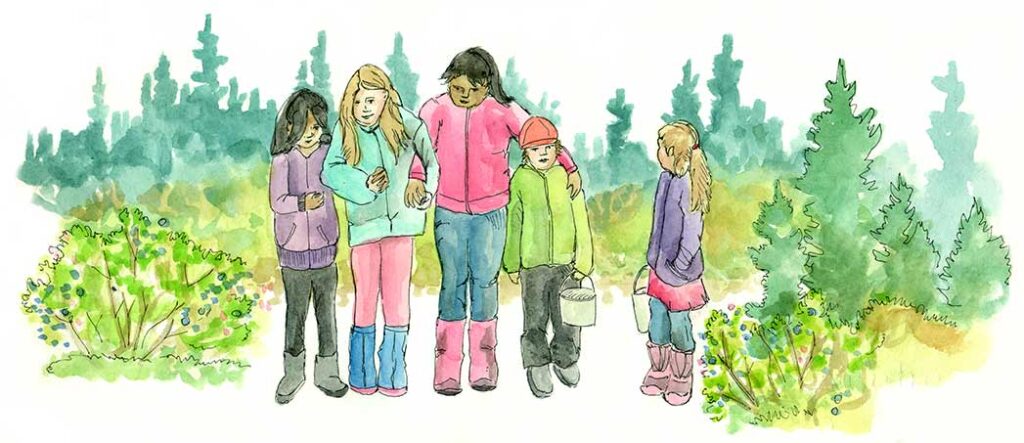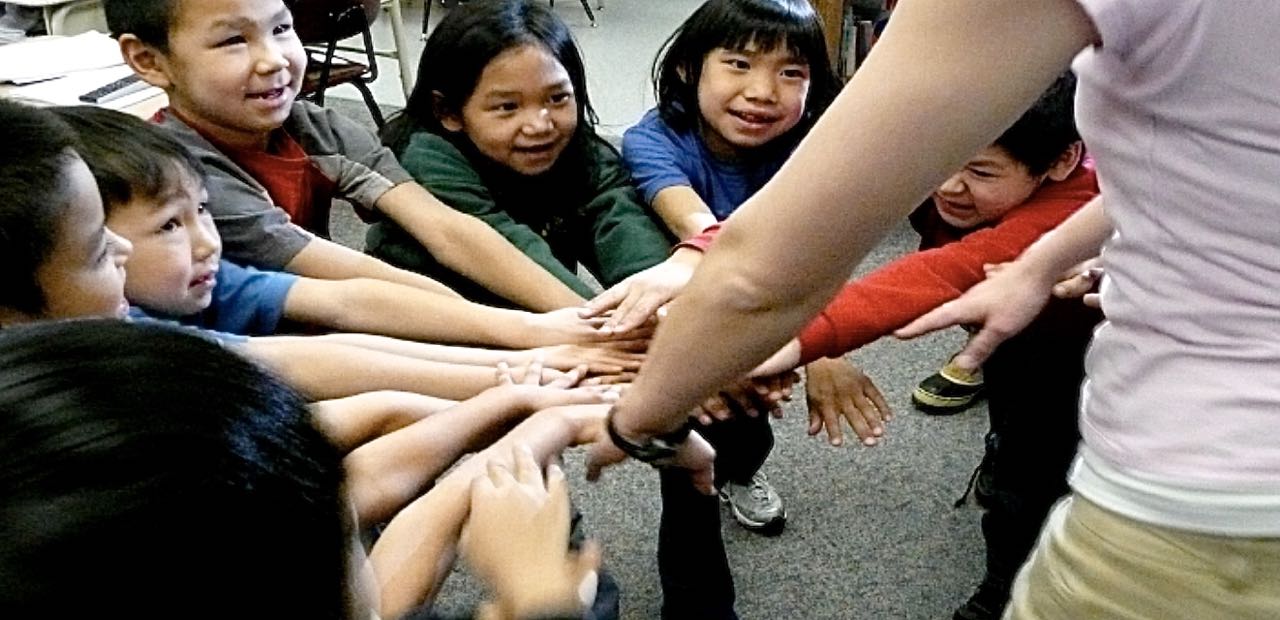
Talk with young people about their families, and notice ways that kids are supported and loved by their family members.
Alaskan teacher
What is this section about?

As a child’s first and most significant teachers, families are essential partners in helping students navigate and succeed in school, and heal from trauma. There is overwhelming evidence that meaningful school-family partnerships improve student achievement and school effectiveness regardless of income or their own educational background.
This section of the toolkit provides tools and resources to partner with parents for social, emotional, behavioral, and academic outcomes.
Community Adaptations
Working with families requires truly listening and understanding their history, values, priorities, and practices. Families are most likely to participate in spaces and schools that acknowledge their culture and contribution and expertise. Building relationships and having a mindset of true partnership with families are the starting points to this work.
Trauma Engaged Schools Knowing to Doing Video Library
The Trauma Engaged Video Library offers over 50 peer-led and statewide experts short videos tied to the topics in the Framework. They are under 10 minutes and easily accessible for personal review or in a group setting to stimulate discussion. Below is the video series for this chapter.
Click on the banner on the top left of the video screen to see the chapter video titles.
What can leadership do?
Families that have experienced trauma or had negative experiences in the school can benefit from strong partnerships, increased advocacy and support. When possible and in a respectful way link families to appropriate support services and resources.
Click each section below for more info.
A. Communicate the importance of family school partnerships and families’ roles in a trauma engaged school to all school staff. Having strong relationships and trust mean that families and school staff can work as a team to better support students with adverse childhood experiences and stress.
- List of presentations and videos for leadership that can help grow understanding of trauma and its impact on learning (10g) Resources.
- A National Education Association Policy brief on the importance and impact of family partnerships on student success.
- Flamboyan Foundation research on why family partnerships matter.
B. Bring together school staff and community to review family surveys and school climate surveys.
- Statewide link to School Climate and Connectedness Survey Resources. Individual school links are available by reaching out to your local school district.
- School Climate & Family Survey (Community & Family Survey). Topical areas and questions can be found on AASB support page for Survey administration.
- Presentation by Brian Rainville on how do you use data you have to help with Family Engagement work/strategies
C. Host dialogues to better understand interests and needs and values of families.
- Overview of First Alaskans Advancing Native Dialogues on Racial Equity (ANDORE) dialogue model, and examples of use.
- Sample Dialogue Flow for Community Conversations (modeled after ANDORE).
- Group Agreements for Community Dialogues, to use to set the norms for the dialogues.
D. Make a plan in partnership with families and school staff that includes a vision for ideal school-family partnerships to support student’s academic and social and emotional learning.
- Strategies for Establishing School-Family Partnerships in Support of SEL
Example of how both families and school staff can work together to support social and emotional development of students, identify practices and systemic changes that will improve family-school partnership.
- Example of a tool to help set goals and with families.
- National Standards (these are standards for family engagement put out by PTA).
- Consider creating a school and community calendar. Add key dates for community celebrations and events onto the school calendar and Facebook posting. Promote these gatherings so staff and families can build connections together.
E. Establish structures and processes for family partnerships. Gather input from families on curriculum design, policy, budget and training for staff related to partnering with families. Families that have experienced trauma or had negative experiences in the school can benefit most from partnerships and opportunities that they can have some control and advocacy role.
- Establish policies and by-laws
- Parent Governance Structures
Information from the National Association of gifted children on how to start a student support group
F. Design professional learning opportunities and social media outreach on family partnership, trauma engaged schools, co-regulations, and social emotional learning:
What can school staff do?
Click each section below for more info.
A. Start each school year by setting goals for connecting with families. Track your goals and progress and use leadership support to measure and meet your goals.
B. Get to know and understand your students‘ families. Approach families with humility and respect and without assumptions.
Getting to know you resource for teachers to discuss with students’ support systems:
Instructions with getting to know you activities:
Ways to learn about families’ values, interests, etc.:
- Questions and preparation for home visit conversations
- Attend community events, celebrations that reflects students’ families, eg. cultural dances, plays, celebrations that are open to public to get to know and see your families outside of the school
Regional resource list (understanding culture, history):
Tools to help understand families experiences with education:
- Molly of Denali video – Highlights experience of boarding school and suppression of language. (whole video or 8:12-11:42)
- High School Student Speech Contest – Jakob Sipary discussing his families experience with education
- Article and reading on historical trauma – might want to sift through
C. Watch videos and review approaches to work more closely with families building connection, confidence, cultural safety, content, or co-regulation.
Family Partnership Framework sections:
- Stronger Together – An Alaska developed resource to deepen understanding of family partnerships (link coming soon)
Videos highlighting approaches to family relationship building strategies:
D. Create opportunities for families to share their knowledge and build confidence, as kids first and most important teacher, especially helping families to understand co-regulation.
- Help understand co-regulation and how much children respond to the adults around them. The video, The “Still Face” Experiment, is widely used to better understand co-regulation.
Understand regulation skills developmentally:
- Self-Regulation Snap Shot #1: A Focus on Infants and Toddlers
- Self-Regulation Snap Shot #2: A Focus on Preschool-Aged Children
- Self-Regulation Snap Shot #3: A Focus on Elementary-Aged Children
- Self-Regulation Snap Shot #4: A Focus on Middle-School Aged Youth
- Self-Regulation Snap Shot #5: A Focus on High-School Aged Youth
- Self-Regulation Snap Shot #6: A Focus on Young Adults
- Co-Regulation From Birth Through Young Adulthood: A Practice Brief
- Family Engagement and SEL
Enhancing social-emotional learning with a whole-school, whole-family, whole-day approach.
- Teachers, Parents, Kids Bond Over Books
Book study example
- SEL Discussion Series for Parents and Caregivers
Create a discussion series for parents and caregivers on social and emotional learning.
- Toolkit of Resources for Engaging Families and Community as Partners in Education provides resources for school staff for understanding family and community engagement, building a cultural bridge, building trusting relationships with families and community through effective communication, and engaging families and community members in data conversations.
What can families do?
A. Identify opportunities to share knowledge about your child, community, culture.
Tools for reflections for families: information to share with school staff:
B. Learn about opportunities to support student’s learning, social and emotional learning, and co-regulation in and out of school.
- Social and Emotional Learning: Strategies for Parents
There are many ways parents can encourage emotionally intelligent behavior in their children. Source: Edutopia
- SEL 101 for Parents
An informational video to inform parents about SEL in schools and provide them with insights into SEL in their own parenting practices in order to support their children’s social and emotional development.
- SEL Toolkit: Family Engagement
Social emotional learning equips students with lifelong skills that carry on outside the classroom. Engaging families helps strengthen these skills and create opportunities for children to identify and express their emotions at home.
C. Start off the school year, building strong relationships with staff to have a solid foundation to problem-solve for student’s best outcome.
- Teacher – share contact information (email, phone) and best times to call; call and invite parents to come in to meet and extend open invitation to call with any questions regarding student, home work, lessons.
- Invite school staff to community events.
D. Create a group for parents to support each other in parenting, SEL skill-building, and school-related topics. Work together to bring ideas, solutions, and good practices to school leadership and staff.
Milestone Guide
The Transforming Schools Guide offers some steps and a starting point to deepen personal growth, establish a common vision with colleagues and community, and remind each of us that this is a process of preparing, starting, applying, and refining our trauma engaged work. Individuals and teams move through the steps and cycle many times to continue to improve upon and deepen our trauma engaged approach. Seeing the path forward and celebrating successes are key components of effective implementation. These Milestone guides offer four levels of section to complete, broken out by role. Each of the 11 components within the framework and toolkit.
